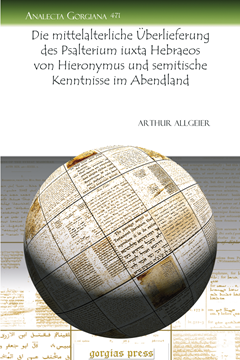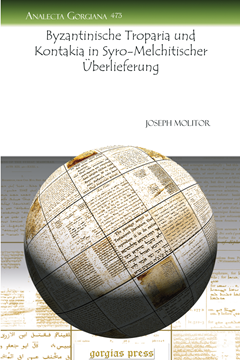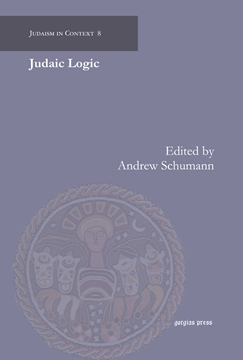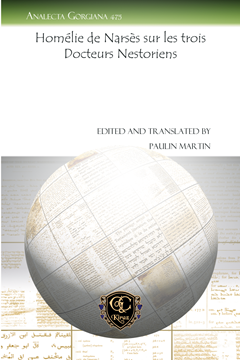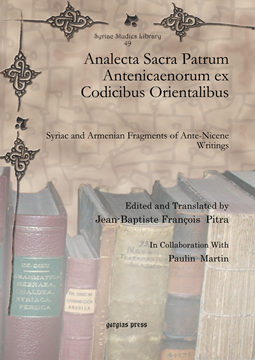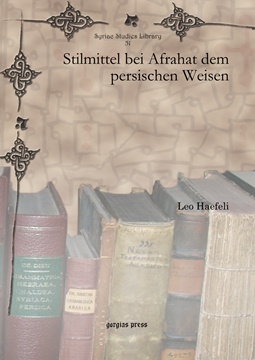Die mittelalterliche Überlieferung des Psalterium iuxta Hebraeos von Hieronymus und semitische Kennt
Series: Analecta Gorgiana 471
ISBN: 978-1-60724-926-9
Arthur Allgeier presents a survey of medieval translations of the Psalms in comparison with the translations of Jerome’s Psalterium iuxta Hebraeos in order to contrast the use of the underlying Hebrew text in the translation.
$38.00 (USD)
Die Enjanehirmen der berliner Handschrift Sach. 349
Series: Analecta Gorgiana 472
ISBN: 978-1-60724-927-6
Odilo Heiming publishes here the Syriac text and German translation of eighty brief Syriac hymns (enjane) that were not included in Jules Jeannin’s Mélodies liturgiques syriennes et chaldéennes.
$39.00 (USD)
Byzantinische Troparia und Kontakia in Syro-Melchitischer Überlieferung
Series: Analecta Gorgiana 473
ISBN: 978-1-60724-928-3
Joseph Molitor traces the influence of Byzantine troparia and kontakia (hymns) in the Syriac Melkite tradition as evidenced by several Syriac manuscripts. Molitor provides a thorough introduction and publishes the Syriac text and German translation for the hymns he surveys.
$50.00 (USD)
St. Peter in Gallicantu
By A.M. Schneider & P. Power
Series: Analecta Gorgiana 474
ISBN: 978-1-60724-929-0
In the first of two articles published here together, A.M. Scheneider challenges the work of P. Power on the location of the house of Caiphas at the church of St. Peter in Gallicantu, and in the second article Power responds.
$40.00 (USD)
Judaic Logic
Edited by Andrew Schumann
Series: Judaism in Context 8
ISBN: 978-1-61719-194-7
Judaic reasoning is discussed from the standpoint of modern logic. Andrew Schumann defines Judaic logic, traces Aristotelian influence on developing Jewish studies in Judaic reasoning, and shows the non-Aristotelian core of fundamentals of Judaic logic. Further, Schumann proposes some modern approaches to understanding and formalizing Judaic reasoning, including Judaic semantics and (non-Aristotelian) syllogistics.
$182.00 (USD)
Homélie de Narsès sur les trois Docteurs Nestoriens
Edited and Translated by Paulin Martin
Series: Analecta Gorgiana 475
ISBN: 978-1-60724-931-3
In this work, Martin offers the Syriac text, with an annotated French translation, of Narsai’s poem on the three doctors of the Church of the East: Diodore of Tarsus, Theodore of Mopsuestia, and Nestorius.
$57.00 (USD)
Midrash and the Exegetical Mind
Proceedings of the 2008 and 2009 SBL Midrash Sessions
Edited by Lieve M. Teugels & Rivka Ulmer
Series: Judaism in Context 10
ISBN: 978-1-61143-683-9
Contained in this volume are the Proceedings of the Midrash session of the SBL's annual conferences in 2008 and 2009. This volume contains eight essays dealing with various aspects of rabbinic interpretation.
$172.00 (USD)
Analecta Sacra Patrum Antenicaenorum ex Codicibus Orientalibus
Syriac and Armenian Fragments of Ante-Nicene Writings
Edited and Translated by Jean-Baptiste François Pitra; In Collaboration With Paulin Martin
Series: Syriac Studies Library 49
ISBN: 978-1-60724-932-0
This work contains a large number of Syriac and Armenian fragments from Ante-Nicene writings, with a translation into Latin and four indices: biblical passages, place names, persons, and subjects.
$220.00 (USD)
Synodicon Orientale
Recueil de synodes nestoriens
Edited and Translated by Jean-Baptiste Chabot
Series: Syriac Studies Library 50
ISBN: 978-1-60724-933-7
This large volume, the essential resource for studying the official doctrine of the Church of the East from the fifth to eighth centuries, contains the Syriac texts, with a heavily annotated French translation, of synods from 410 to 775.
$258.00 (USD)
Stilmittel bei Afrahat dem persischen Weisen
By Leo Haefeli
Series: Syriac Studies Library 51
ISBN: 978-1-60724-934-4
Drawing on the more progressed fields of Greek and Roman and Arabic rhetoric, Haefeli here presents Aphrahat’s style in terms of numerous stylistic categories. Naturally, the work is brimming with examples (in Syriac and German) from Aphrahat.
$138.00 (USD)
